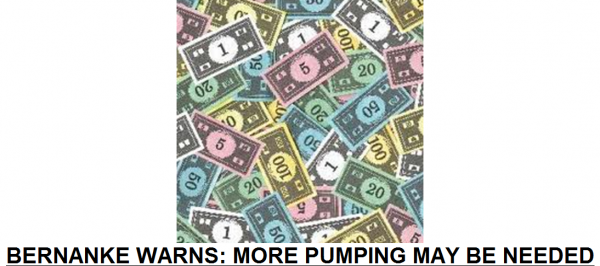Ben Bernanke was a market monetarist (in 2003)
With apologies to Drudge:
Commenters dwb and Jim Glass sent me an amazing piece written by Bernanke in 2003:
The only aspect of Friedman’s 1970 framework that does not fit entirely with the current conventional wisdom is the monetarists’ use of money growth as the primary indicator or measure of the stance of monetary policy. Clearly, monetary policy works in the first instance by affecting the supply of bank reserves and the monetary base. However, in the financially complex world we live in, money growth rates can be substantially affected by a range of factors unrelated to monetary policy per se, including such things as mortgage refinancing activity (in the short run) and the pace of financial innovation (in the long run). Hence, it would not be safe to conclude (for example) that the recent decline in M2 is indicative of a tight-money policy by the Fed.
The imperfect reliability of money growth as an indicator of monetary policy is unfortunate, because we don’t really have anything satisfactory to replace it. As emphasized by Friedman (in his eleventh proposition) and by Allan Meltzer, nominal interest rates are not good indicators of the stance of policy, as a high nominal interest rate can indicate either monetary tightness or ease, depending on the state of inflation expectations. Indeed, confusing low nominal interest rates with monetary ease was the source of major problems in the 1930s, and it has perhaps been a problem in Japan in recent years as well. The real short-term interest rate, another candidate measure of policy stance, is also imperfect, because it mixes monetary and real influences, such as the rate of productivity growth. In addition, the value of specific policy indicators can be affected by the nature of the operating regime employed by the central bank, as shown for example in empirical work of mine with Ilian Mihov.
The absence of a clear and straightforward measure of monetary ease or tightness is a major problem in practice. How can we know, for example, whether policy is “neutral” or excessively “activist”? I will return to this issue shortly.
After reading that my heart started pounding so hard I thought I was going to have a heart attack. I could hardly wait to find out what Bernanke thought was the right variable. Surely it couldn’t be NGDP? Recall all the times I’ve be ridiculed over the last three years for saying money has been incredibly tight since 2008. Early on even some market monetarists didn’t like that characterization–preferring something less wacky sounding, like “not stimulative enough for on target NGDP growth.” Almost no one agreed with my claim that money was as tight as it’s been since 1938. Turns out it was even tighter than that.
Finally I reached the end of the article, where Bernanke returned to the question of how we tell whether money is easy or tight:
Do contemporary monetary policymakers provide the nominal stability recommended by Friedman? The answer to this question is not entirely straightforward. As I discussed earlier, for reasons of financial innovation and institutional change, the rate of money growth does not seem to be an adequate measure of the stance of monetary policy, and hence a stable monetary background for the economy cannot necessarily be identified with stable money growth. Nor are there other instruments of monetary policy whose behavior can be used unambiguously to judge this issue, as I have already noted. In particular, the fact that the Federal Reserve and other central banks actively manipulate their instrument interest rates is not necessarily inconsistent with their providing a stable monetary background, as that manipulation might be necessary to offset shocks that would otherwise endanger nominal stability.
Ultimately, it appears, one can check to see if an economy has a stable monetary background only by looking at macroeconomic indicators such as nominal GDP growth and inflation. On this criterion it appears that modern central bankers have taken Milton Friedman’s advice to heart. (Emphasis added with pride.)
Yes !!! Now all that remains is to ascertain the rate of NGDP growth since the second quarter of 2008: 6.1%.
That is not a 6.1% annual growth rate, that’s the total growth in NGDP since 2008:2. And when was the last time NGDP grew that slowly over a 3 1/2 half year period? Hint: Herbert Hoover was President at the time.
And then the concluding paragraph:
In summary, one can hardly overstate the influence of Friedman’s monetary framework on contemporary monetary theory and practice. He identified the key empirical facts and he provided us with broad policy recommendations, notably the emphasis on nominal stability, that have served us well. For these contributions, both policymakers and the public owe Milton Friedman an enormous debt. (Emphasis added)
That’s why Ben Bernanke was my first choice for Fed chairman. He gets it. He understands that the job of the monetary policymaker is to focus like a laser on nominal stability.
PS. Some killjoy may point out that Bernanke mentioned both NGDP and inflation as indicators of the stance of monetary policy. OK, here’s the total inflation between July 2008 and January 2012: 3.8%
That’s not 3.8% CPI inflation at an annual rate over the past 3 and 1/2 years (which would still be lower that the rate Volcker produced in the mid-1980s) it’s a total increase of the CPI of 3.8% over 3 and 1/2 years, barely 1% per annum! The Fed’s goal is 2%.
So can everyone now agree that Fed policy has been incredibly tight since 2008?
Interestingly, Bernanke is no longer a market monetarist, at least in public. He now likes to emphasize at press conferences how extraordinarily accommodative Fed policy has been since 2008. But that’s not what he really believes. That’s what a man in his position is forced to say. For what he really believes reread his powerful testimonial to Milton Friedman from 2008 2003, and especially this part:
Ultimately, it appears, one can check to see if an economy has a stable monetary background only by looking at macroeconomic indicators such as nominal GDP growth and inflation.
That’s “only by looking” folks. That means there is no other way. Money supply won’t work. Interest rates won’t work. Only NGDP or inflation can tell you the stance of monetary policy. Every conservative who’s been complaining that Bernanke’s running an inflationary monetary regime needs to read this post, and verify the accuracy of my NGDP and CPI data. And then admit they made a tragic mistake. Now let’s see who’s got the guts to step up to the plate.
PS. How did this amazing Bernanke piece slip through the cracks for 3 years?
Update: The conventional wisdom, courtesy of Drudge:



